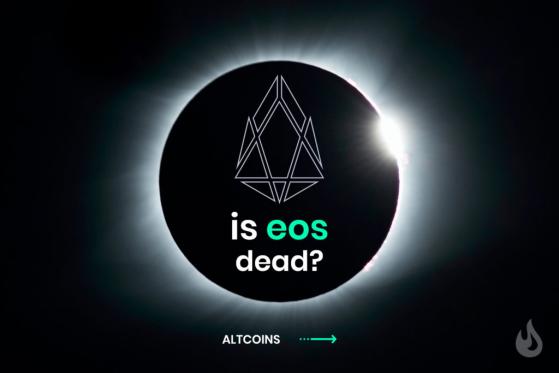2017 was the year smart contract platforms and the blockchain ecosystem started to challenge digital conventions. The same year constituted the ‘gold rush’ in terms of platform development, facilitated by ICO’s emergence in a highly unregulated market. In 2017 smart contracts were the equivalent of NFTs in 2021 or DeFi in 2020 and 2017 was the year the majority of existing blockchain networks developed and increased their market cap.
Substantial funds were raised by ICO projects throughout 2017 and retail investors backed projects based on a speculative future that was yet to be realized. Projects such as Tron, Ethereum, Cardano, or IOTA remained relevant and created functional blockchain ecosystems. EOS was one of the leading projects of 2017 and hoped to dethrone Ethereum due to its easy-to-implement infrastructure.
EOS and the Future of Smart Contract Platforms
EOS platform is developed by Block.One which, in 2017, ran a year-long ICO which amounted to over $4 billion. The length and sum of the ICO drew a lot of attention to the project. With all the media attention, EOS was fined $24 million in 2019 by the SEC for running an unregistered ICO.
EOS was developed by Dan Larimer, who also founded projects such as Steem or Bitshares. EOS functions in a similar way to other blockchain networks but with some notable differences; The ecosystem uses a Proof-of-Stake consensus mechanism; it can support over 4,000 transactions per second making it a solid competitor for Ethereum which faced network congestion in the past; it promotes free usage for dApps users and developers as it does not require users to pay transaction fees on the platform.
The launch of their mainnet was delayed in 2018 by one week. It was one of the first indicators that EOS, despite their hype and promises, would have issues delivering their product. Hackers managed to hack Block.One’s Zendesk (NYSE:ZEN), sending phishing e-mails to users. Then, a Chinese security firm discovered vulnerabilities in the EOS network, where hackers could take full control of the nodes due to vulnerabilities.
Did EOS Sell a False Promise?
Although good technology and vision are the backbones of any successful start-ups, this doesn’t always yield results. As EOS discovered, their actions and failure to meet community expectations turned out to be their main flaw.
EOS’ infrastructure allows developers to develop dApps on the EOS network, and they make programming and implementations much easier. However, as EOS became more centralized in governance, developers discovered the high entry point and challenges associated with the network.
Deploying apps on EOS requires developers to rent CPU and NET, and purchase RAM. This helps Block.One develop a secondary market that is susceptible to speculation. Despite the lack of transaction fees, only one dApp was deployed on EOS in July 2020, compared to 32 on Ethereum. Still, EOS has the second largest number of total dApps deployed on the network and more transactions than Ethereum.
The high entry point for using EOS has forced developers to fork EOS and create more sustainable and efficient platforms such as Telos or WAX. The community in this regard is becoming segmented and there are concerns that retail investors’ funds were only used to increase Block.One’s profit margins.
On the Flipside
- EOS has more transactions on the network than Ethereum and still holds 2nd place for a total number of dApps.
- After the SEC fine, Block.One is reluctant to deploy new applications that do not meet regulator standards.
- EOS is focused on building up other platforms such as Voice.com using EOSIO.
What Does the Future Hold For EOS?
Dan Larmier resigned as CTO from Block.One in December 2020 triggering a spiral effect on the overall network. Popular Youtube personality Colin Talks Crypto disclosed he sold “100% of his EOS”, pointing out that EOS is on a declining slope.
EOS faced several issues in the past years, one of which was network congestion. This came as a result of an airdrop done by EIDOS as transactions nearly quadrupled. What’s more, the community signifies centralized governance as the main catalyst for EOS’ decline. With such monetary incentives, nodes with a deep pocket took over the governance of the network for their own interest. Luke Strokes stressed the secrecy surrounding Block.One and how this hinders the evolution of the network.
Most recently, Block.One has been vocal about their shift in strategy and their approach to create a Bitcoin support layer using EOS. While initially investors backed EOS to better existing smart contract platforms, the shift towards Bitcoin does not match their shared ideas.
EOS failed to adapt to the market demands and develop a DeFi platform similar to Uniswap or Pancakeswap. Inexistent fees on EOS could have created a better ecosystem for DeFi to flourish; however, EOS failed to meet developers halfway. EOS failed to meet Effect Network’s needs, which switched their DeFi development from EOS to Binance Smart Chain. The company claimed concerns in the future of EOS and its governance structure.
